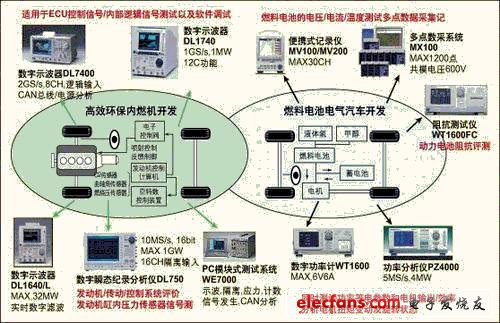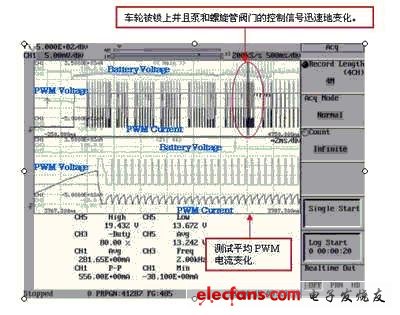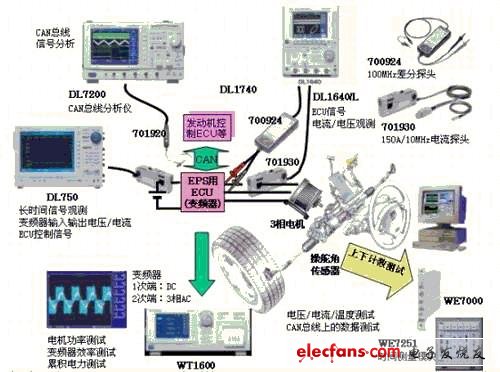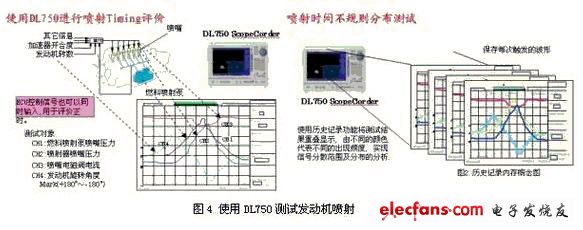With the increase of electronic systems in automobiles, how to conduct high-efficiency testing of highly mechatronics automotive systems is a challenge for Chinese test engineers. As a result of various test questions involved in the automotive R&D process, please contact Yokogawa. Introduce a complete solution for engine, drive, vibration, environmental impact, fuel cell efficiency and CAN bus testing needs.
This article refers to the address: http://
I. Introduction
With the development of the automotive industry and the electronics industry, more and more electronic technologies are being applied to modern automobiles. Automobiles will also evolve from purely mechanical products to advanced mechatronic products. As real-time driving information systems and multimedia devices are popularized in automobiles, cars are more personalized, versatile, safe and comfortable. Wireless and mobile computer technology is rapidly evolving, and even if you drive alone on unfamiliar land, you will not feel lonely or lost. Cars are not just a means of transportation in people's lives, but gradually become a way to enjoy life. Research in the field of automotive electronics has become the most active part of automotive R&D, and the results achieved in this area will yield greater returns in the market.

This paper introduces various test solutions provided by Yokogawa for engine analysis, drive analysis, vibration analysis, environmental impact, fuel cell efficiency analysis, and CAN bus analysis involved in the automotive R&D process (Figure 1).
Second, electric vehicle fuel cell testing
For engineers engaged in automotive R&D, the following aspects of testing are important factors that affect test efficiency and results:
(1) Various high-frequency and low-frequency, high-power and low-power electromagnetic radiation interference (2) Common mode power, vibration, and variable environment (3) Reliability of data acquisition and analysis (4) Instrumentation during road test Power supply and energy consumption (5) Easy to move and use on site
By communicating with test engineers in automotive production R&D companies, Yokogawa continues to improve its products to better suit the needs of automotive research and development. For example, in order to meet the research needs of electric vehicle fuel cells, Yokogawa developed the DAQMaster series MX100 based on the DARWIN series.
Because each battery only outputs 0.8-1.5VDC, in order to output enough power. Fuel cell stacks typically consist of approximately one hundred single cells, particularly for automotive applications, which consist of six hundred single cells. The Battery Voltage Monitoring (CVM) system detects faulty batteries by testing the voltage of each single cell in the battery pack configuration; analyzing battery performance during live or long-term operation with load.
Use differential input when detecting battery voltage. Although the voltage of the single-cell battery is not high, the differential input terminal generates a voltage of several hundred volts to the ground of the test instrument. This voltage is called the common mode voltage. Most data acquisition instruments (DAQs) are not insulated and the input voltage limit is typically 5 volts or 10 volts. In addition, non-insulated instruments are often susceptible to ground loops. In order to overcome the problem of high common mode voltages in fuel cell CVM systems, high voltage insulation is required. Although external signal converters or buffers can be used, many DAQ systems now have built-in buffers in order to ensure high signal resolution and accuracy while reducing size and cost.

MX100
DAQMaster provides the highest level of channel-to-ground, inter-module and channel-to-channel isolation. In addition, its modular structure and standard software make the MX100 easy to monitor up to 1200 channels of battery voltage.
Simultaneous design of high voltage isolation and multi-channel DAQ systems is a challenge because most data acquisition instrument modules use a single AD converter combined with front-end multiplication or scanning. The high common mode voltage signal must be switched by switching the relay before it is insulated and discretized by the isolation transformer and the AD converter.
The MX100 uses Yokogawa's patented high-voltage solid-state semiconductor relay in the scanner to switch between multi-channel input signals. This relay consists of a high-voltage (1500VDC), low leakage current (3nA) MOSFET (metal oxide semiconductor). The field effect transistor) and the voltage output optocoupler are composed of 10 channels of high-speed scanning, no contact, long life, no noise, etc. in a one second period.
In addition, the internal insulation transformer and integral AD converter of the MX100 are also patented by Yokogawa. Other DAQ systems that use electromagnetic relays to provide insulation create switching time, switching stability, and routine maintenance issues. Finally, the MX100 DAQMaster provides high performance isolation and 4-channel simultaneous sampling because the hardware of each channel of the 4-channel module consists of separate hardware.
For correct reproduction of the waveform, the sampling rate is very important, and high-speed acquisition can get the correct data. For this MX
The minimum measurement period of 100 is 10ms, and three measurement cycles can be mixed in one system. The measurement cycle can be set individually for each module. The MX100 supports CF cards with a maximum capacity of 2G Bytes and starts data backup when communication fails. When the communication returns to normal, the data transfer to the PC is automatically started again. The MX100's high-speed/multi-channel/high-voltage/multi-cycle characteristics for fuel cell testing help test engineers improve the efficiency and accuracy of their tests.
Third, CAN bus analysis
Automotive bus technology is widely used in today's automobiles. The car bus provides a unified data exchange channel for various complex electronic devices, controllers, measuring instruments, etc. inside the car. The number of components controlled by electronic control units (ECUs) in automobiles is increasing, such as electronic fuel injection devices, idle speed control (ISC), anti-lock braking devices (ABS), airbag devices, electronically controlled doors and windows, and active Suspension and so on. With the widespread use of integrated circuits and microcontrollers in automobiles, the number of ECUs on the car is increasing.
Therefore, a new concept - the concept of CAN on the car controller area network came into being. CAN was originally developed by the German company BOSCH to solve the data exchange between the control and test instruments in modern cars. According to the relevant ISO standards, the topology of CAN is bus type, so it is also called CAN bus. .
With the wide use of CAN bus, the testing and analysis of bus signals in all aspects of automobile R&D, production and maintenance becomes more and more important, especially the observation and analysis of noise signals.

The abnormality caused by the cable wiring length, the reflection noise caused by the terminal impedance position, or the overload LEVEL change when connecting multiple contacts can be triggered by the CAN signal of the DL7400 series, capturing the CAN bus signal and displaying its waveform. The analysis according to the CAN protocol is displayed together with the waveform signal in the form of a list. The trigger condition can be set to a field or a multi-field of CAN data frames (ID, Data, RTR bits, etc.). The trigger can also be activated in the event of an error frame. The captured CAN bus waveform data can be analyzed on the time axis, and the ID and data of each frame are displayed in hexadecimal or binary symbols.
Fourth, battery voltage fluctuations during ABS operation
The ABS control device monitors whether the wheel is locked by comparing signals from speed sensors attached to each wheel. When the ABS control detects that a wheel is locked, it sends a signal to the ABS transmission to open the valve. The ABS transmission includes a solenoid valve, a pump, a motor, and a brake fluid tank. Opening the valve can instantly reduce the disc hydraulic pressure, reduce the braking force, and restore the wheel speed.
Then, the disc hydraulic pressure is quickly increased again, and the braking force is increased by the ABS transmission. In other words, the brake can be prevented from being locked by increasing or decreasing the disc hydraulic pressure. Adding disc hydraulics means pumping liquid into the cylinder, which will make the pump motor work quickly. This fast motor will affect the PWM current signal that controls the solenoid valve. General ABS operation cannot get this whether it affects battery voltage fluctuations. Therefore, it is necessary to observe this battery voltage fluctuation.
The DL750 Max.1GW long memory allows high-speed sampling to capture all braking actions from start to finish. You can also use the zoom function to test one of the irregular parts in detail after capturing the overall process. This feature automatically sets the automatic test area for waveform parameters, including the zoom area. This amplification function not only accurately tests irregularities in one cycle but also automatically tests waveform parameters in the amplified region.
Five, power steering control ECU (including inverter) / motor development
The power steering wheel (EPS) has become more popular in small cars, but it requires a 3-phase motor for use in large vehicles requiring high torque. Unlike traditional DC machines, testing 3-phase AC motors requires power meter test power and Efficiency. In addition, CAN bus communication is used between ECUs, and CAN bus signals must also be tested.
The DL7400 can trigger on specific ID/Data on the CAN bus for simultaneous observation with other signals. The general-purpose oscilloscope DL1640/DL1740 can test the CPU signal of the ECU. The 100MHz differential probe and the 150A current probe can also test the inrush current of the motor. The DL750 has a maximum of 16ch insulation input for long-term observation of the inverter input/output voltage/current and ECU control signals.
The WT1600 can evaluate the 3-phase current/voltage/power of the 1st-end DC and 2nd-end of the 3-phase drive system inverter for large-scale automotive EPS, and the inverter efficiency. Cumulative power testing is also possible for specific operating modes. Multi-channel integrated testing can be achieved using the WE7000 time module/CAN module/isolated A/D module/temperature module. Multiple angles such as steering angle/current consumption/voltage/temperature are tested at the same time for a long time. Using the CAN module, the data on the CAN bus can be simultaneously converted into physical quantities for simultaneous testing.
Sixth, direct injection diesel engine injection experiment
Direct-injection diesel engines can reduce fuel costs and purify exhaust emissions. The following is a key solution for the development of high-pressure injection and electronic control performance evaluation methods:
(1) Evaluation of the design value of the mechanical part (injection time and injection pressure)
The test object is the injection pressure of the fuel injected by the nozzle, the change of the engine speed and the switching time of the nozzle solenoid valve. Engine development requires dynamic testing (gradually improving engine speed checks to meet design requirements) and static testing (checking for stable operation at fixed speeds).

(2) Synchronous test with ECU control signal
Tested in parallel with the ECU control signal to test the ECU timing and actual injection timing.
Seven, the summary of this article
Yokogawa has many test cases in this area due to its extensive cooperation with vehicle and component companies around the world. Yokogawa hopes to contribute to the development of automotive electronics.
Drum type Rice Cooker
Features
This type rice cooker is famous with drum type appearance, which is easy operation and easy clean.
There are two type of inner pot , one type called white pot which is without non-stick but cheaper price .another one called non-stick pot is polished with emery, Also there are two type non-stick with different price ,it`s depending on different demands to use.
And the inner pot cannot be burned on the stove, which will make the pot transfigured and bad contact with the heating plate. While cooking , the heating plate or the fuse is most likely to be burned for the bad contact of the inner pot and the heating plate, Besides, make sure to dry the pot before putting into the outer shell of the rice cooker ,or else the drops of water flowing on the heating plate, will make the heating plate rusted.
Applications
Many peoples are used drum type rice cooker for congee and soup, some of peoples are prefer to use this type rice cooker for steaming.
Drum Rice Cooker,Drum Shape Rice Cooker,Electric Drum Rice Cooker,Multifunctional Drum Rice Cooker
Guangzhou Taipeng Electrical Appliances Technology CO., LTD. , https://www.taipengelectric.com
